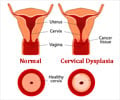
‘Children born to parents with high occupational standing faced higher risks of melanoma and prostate cancer and, for women, greater risks of breast cancer.’
Tweet it Now
The study found that for those born in neighborhoods with low socioeconomic status in relation to those from high status neighborhoods, women faced greater risks of invasive cervical cancer. In these low SES neighborhoods, men faced lower risks of prostate cancer, and overall (both sexes) the risk of melanoma was lower. The researchers used the Utah Population Database (UPDB), a unique computerized research resource that contains records from many sources, including genealogies, Utah birth and death certificates, hospitalization records, and driver's license data, to analyze cancer incidence of the study group.
The study evaluated data from individuals who were born in Salt Lake and Weber Counties during 1945-1959 and who survived and lived in Utah until at least age 18. Demographic data were linked to cancer incidence information catalogued in the Utah Cancer Registry to evaluate cancer trends in the general population compared to the study group.
According to the senior author Ken Smith, Ph.D., a population health researcher at Huntsman Cancer Institute and a distinguished professor of family studies and population science at the University of Utah, "This study shows that early-life socioeconomic status, based on factors such as parental occupation at birth, may be associated with cancer risk in adulthood. Using this information, we may be able to identify individuals who are at higher risk for cancer due to socioeconomic status at birth, and ideally, work to find strategies to help them manage their cancer risk in adulthood."
Smith noted that the association between SES and breast, cervical, and prostate cancer might reflect SES differences in participation in cancer screening. He also said the importance of critical periods in a child's development may be affected by exposures and living conditions that can lay the foundation for later cancer risk and contribute to social differences in cancer risk.
Advertisement















